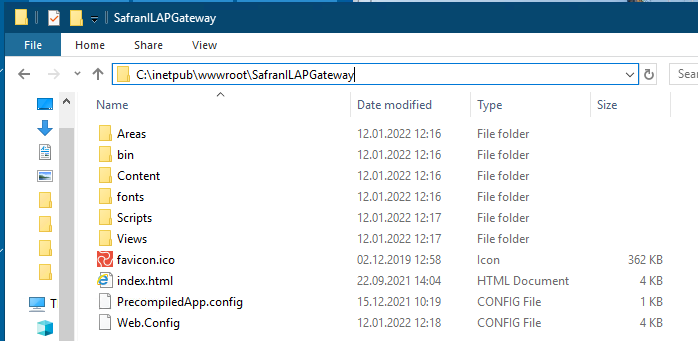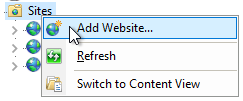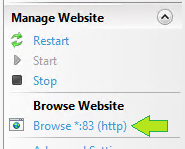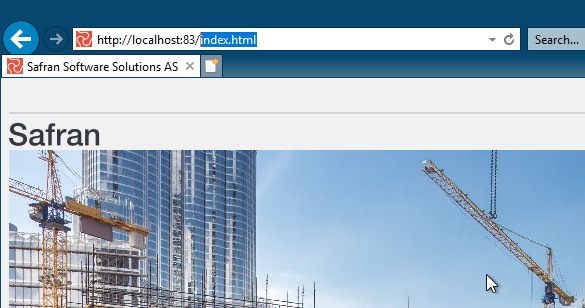Installation
Upon deployment, the following guide may be used; notice that the steps outlined below may change, and the screenshots used may differ depending on the Operating System the API is being deployed on.
In case you have version 7.3 or earlier of the API then this page is for you. Should you have a newer version of the API please refer to the updated installation guide.
Prerequisite
Before installing the Safran Software solution, a few elements must be present.
- Within the Windows "Control Panel" under "Turn Windows features on or off," the following needs to be present:
- Internet Information Service – Web Management Tools – IIS Management Console
- Internet Information Service – Application Development Features - .Net Extensibility 3.5
- Internet Information Service – Application Development Features - .Net Extensibility 4.8
- Internet Information Service – Application Development Features – ASP.NET 3.5
- Internet Information Service – Application Development Features – ASP.NET 4.8
- Internet Information Service – Application Development Features – ISAPI Extensions
- Internet Information Service – Application Development Features – ISAPI Filters
- Internet Information Service – Common HTTP Features – Default Document
- Internet Information Service – Common HTTP Features – Directory Browsing
- Internet Information Service – Common HTTP Features – HTTP Errors
- Internet Information Service – Common HTTP Features – Static Content
- Internet Information Service – Health and Diagnostics – HTTP Logging
- Internet Information Service – Performance Features – Static Content Compression
- Internet Information Service – Security – Basic Authentication
- Internet Information Service – Security – Request Filtering
- Internet Information Service – Security – Windows Authentication
- DBMS 64 client drivers were downloaded from the respective vendor.
- For Oracle and the clients, the ODAC 64bit (Oracle Data Access Components) package is required.
- Notice that "System.Data.OracleClient requires Oracle client software version 8.1.7 or greater.
- Microsoft SqlClient Data Provider for SQL Server (.NET Framework Data Provider for SQL Server) is required for MS SQL Server database.
- Database setup and available from the server where Safran software is being installed.
Setup the Safran Solution
This document will guide the reader through the setup of Safran Solution as Safran ILAP Gateway and Safran Project Integration API. Both will be referred to as "Safran Solution". This document will also describe how to verify the installation and setup.
Install the Safran Software solution
The steps outlined here will guide the reader through installing the Safran Solution on a web server. This applies to Safran ILAP Gateway, Safran Project Integration API, and other similar solutions.
- Collect the Safran Solution, which is most likely delivered as a compressed zip file.
- On the Windows server where the Safran Solution is to be installed, open a File Explorer window.
- Navigate to the folder "C:\inetpub\wwwroot"
- Create a new subfolder named "SafranILAPGateway" or "SafranIntegrationAPI", depending on which system to install. Should you prefer another name, use such instead.
- Extract the delivered compressed zip file into the newly created subfolder.
- Your subfolder should look something like this:

Setup Internet Information Services (IIS) Manager
The steps outlined here will guide the reader through adding the Safran Solution as a web service in the IIS software. This applies to Safran ILAP Gateway, Safran Project Integration API, and other similar solutions.
- Open the START menu on the Window on the server where the Safran Solution will be installed.
- Type "iis" while the start menu is open.
- Internet Information Service (IIS) Manager is opened.
- On the left-hand side, locate the "Sites" folder and select to expand it. There may or may not be sites already added to the IIS.

- Right Mouse click the "Sites" item and select "Add Website…" from the popup menu.

- The "Add Website" dialog opens

- The following input fields need to be configured:
- Port
- Defined the port where the Safran System is accessible. In this example, I have selected "83."
- IP address
- This is typically left as is
- Type
- Select HTTP or HTTPS; the recommendation is to use HTTPS; in this sample, I will choose HTTP. See IIS documentation for details on HTTPS.
- Host name
- This is typically left blank.
- Site name
- This is the application's name, and as a good practice, the name should also include the port number.
- In this sample, I added the Safran Solution: Safran ILAP Gateway, with port 83; therefore, I chose "SafranILAPGateway 83" as the name."
- Application pool
- This is typically left as is
- Physical path
- This will point to the subfolder where the compressed zip files were extracted and the Safran Solution's placement.
- "C:\inetpub\wwwroot\SafranILAPGateway"

- Port
Firewall
Make sure that the server hosting the Safran solution has an open port on its firewall, which corresponds to the port defined in the IIS setup.
Database connection
Within the subfolder where the Safran Solution was installed. There is a file called "Web.Config". We need to adjust this to connect to our database. It is assumed that all DBMS software is installed.
I installed the respective 64-bit database client software for Oracle and Microsoft.
- Open the "Web.Config" in your installed subfolder using Notepad.
- The file is split into sections, located in the section called "<configuration>" and section "<connectionStrings>"
- Within the last section, there is a line starting with "add name="default" connectionString", this is the line which needs to be updated.
- For the Microsoft SQL server, the content should be as such, and the text in green needs to be updated:
- <add name="default" connectionString="Data Source=AAAA;Initial Catalog=BBBB;User ID=CCCC;Password=DDDD" providerName="System.Data.SqlClient" />
- AAAA must be set to the IP or DNS name of the database server.
- BBBB needs to be set to the name of the database on the database server.
- CCCC is the database user the Safran Solution will use to connect to the database. Typically, this is SAFRANSA, but it could also be another user. The user must have access to the tables within the Safran Database.
- DDDD is the database password for the user defined in CCCC.
- For Oracle, the content should look as such, and the text in green needs to be updated:
- <add name="default" connectionString="Data Source=AAAA;User ID=BBBB;Password=CCCC;timeout=10" providerName="System.Data.OracleClient" />
- AAAA Is defined in "Oracle Net Manager" as a "Service Name".
- BBBB is the database user the Safran Solution will use to connect to the database. Typically, this is SAFRANSA, but it could also be another user. The user must have access to the tables within the Safran Database.
- CCCC is the database password for the user defined in BBBB.
Setup tests
These steps guide the reader through initial tests to verify the installation and setup are working.
-
Within the IIS, select the newly added Site.
-
Ensure the site is running, indicated with a grey "Start" option on the right-hand side.
-

-
Within the IIS, select the added Site and choose "Browse" from the options on the right-hand side.
-

Browser site test
- An empty Internet Explorer window should open. It should also show the Safran Software Solutions logo.

- Within the address, add "index.html" and press [enter]
- The page should load and present content

Safran Solution accessibility test
- In the address bar, replace "index.html" with "v1/test" and enter.
- With "Safran ILAP Gateway", we will correctly get "400 Bad Request"
- With another solution, we will get a "200 Success" replay.
- If you get messages such as "Invalid license, " your web.config file may not be as it should be. Please see below for a sample file.
- In the address bar, replace "v1/test" with "v1/version?type=json" and enter.
- Regardless of Safran Solution, the user should receive the solution version details.
Safran Solution client test
This test will be conducted on a computer different from the server where the Safran solution was installed. This is to ensure firewalls are open and the Safran Solution is accessible outside the server environment.
- Collect the address of the IIS server, either IP or the server's name.
- Start an internet browser software, and within the address field, enter the server's address and add "index.html", press enter.
- The index page should present it selves.
- Within the index page, scroll to the bottom and press the check version and database connectivity. As a result, the user should receive the Safran Solutions version details.
- Access these URLs from the client:
- "/v1/project_previews/"
- "/v1/project_previews/?owner=safran" – where safran is a real Safran user owning projects.
Additional database test
Oracle
Access to database objects
- The system is accessing Oracle system tables, views and synonyms, such as 'USER_TAB_COLUMNS'. These are public by default configuration and must be accessible for the database user defined in the connection string in the "Web.Config" file.
- Perform accessibility test by running this SQL towards the Safran database connected as the user-defined as described above.
- The SQL command below should return records as a result.
- The system is also accessing Oracle system table, views and synonym: 'DBA_USERS',
SELECT COLUMN_NAME, DATA_TYPE FROM USER_TAB_COLUMNS WHERE upper (table_name) = 'NETWORKS';
Microsoft SQL
Access to database objects
-
The system is accessing Microsoft system tables and views, such as 'information_schema.columns'. These are public by default configuration and must be accessible for the database user defined in the connection string in the "Web.Config" file.
- Perform accessibility test by running this SQL towards the Safran database connected as the user-defined as described above.
- The SQL command below should return records as a result.
SELECT column_name, data_type FROM information_schema.columns WHERE upper (table_name) = 'NETWORKS';
Additional configuration
This concludes the installation and configuration of the Safran Solution. See chapter Application Settings for details about the web.config file. It is recommended to apply security and additional configuration. See those chapters for that information.
web.config file
See Configuration File for a sample of the file content.